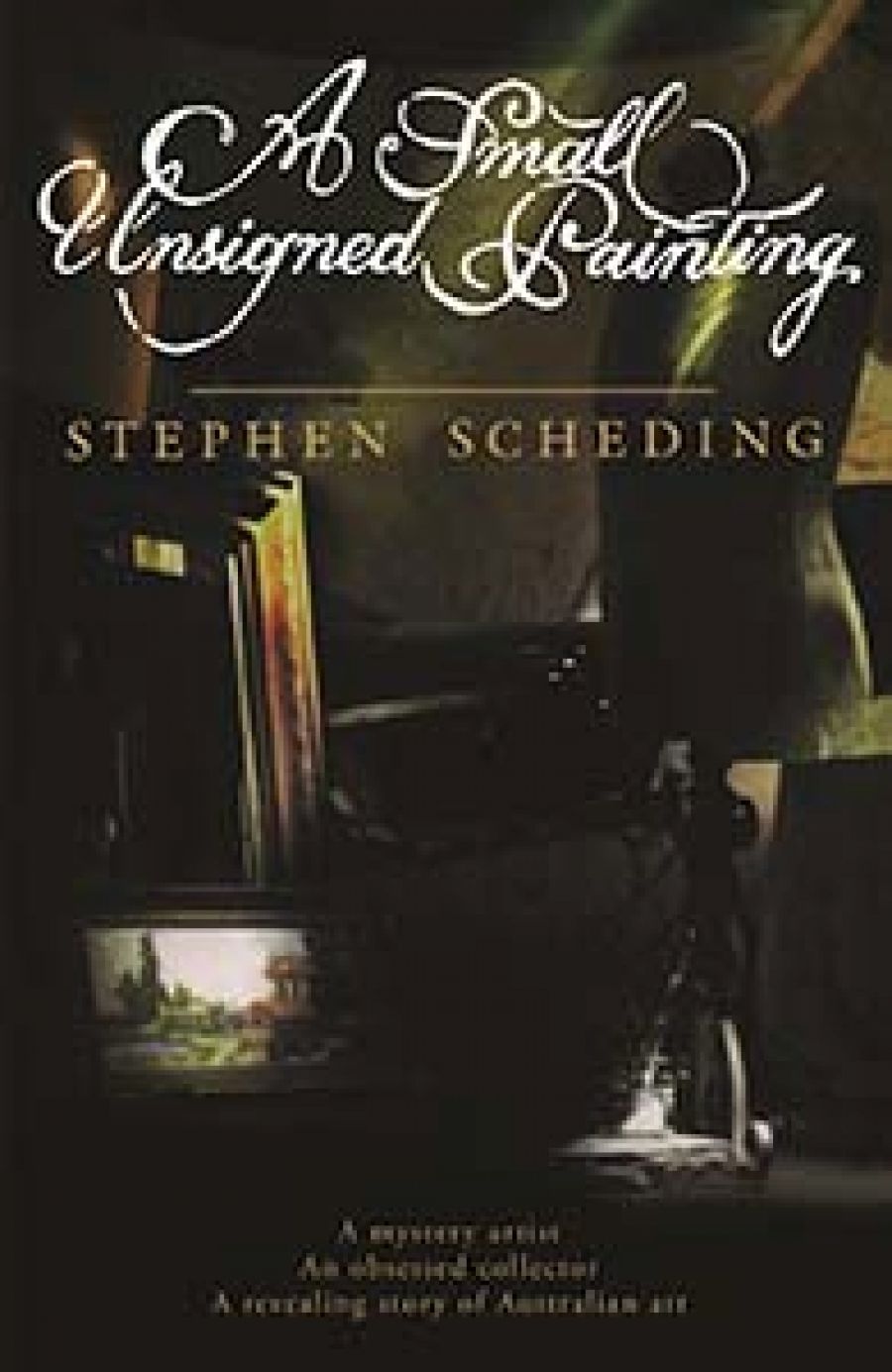
- Free Article: No
- Contents Category: Art
- Review Article: Yes
- Article Title: Art Sleuth
- Online Only: No
- Custom Highlight Text:
This book, a tale of Stephen Scheding’s search for the artist of ‘a small unsigned painting’ he was unable to resist buying at an art auction, has already been warmly reviewed by others as an excellent read, a sleuth story that captures the frustrations and joys of research while holding its reader in a state of suspense worthy of the best whodunnit. I heartily agree and warmly recommend the book to anyone, amateur or art professional, looking to while away a pleasurable and interesting few hours.
- Book 1 Title: A Small Unsigned Painting
- Book 1 Biblio: Vintage $19.95 pb, 292 pp 18 colour plates, 21 black and white
While this aspect of the book – a good and well-told story and a fascinating look at the Australian art world, both past and present – is reason enough to read it, Scheding’s work also raises deeper issues.
First, one that has the power to cause havoc in the art world – that of connoisseurship. We have witnessed in recent years the functioning of the ‘Rembrandt committee’, a selfappointed group with the power to send the value of previously attributed paintings plummeting by deciding they were not painted by Rembrandt. So how is the artist of a painting determined if the work is unsigned? Does it matter who the artist is? Why? Scheding’s book, perhaps unwittingly at times, shows the inconsistencies, illogicalities and paradoxes of the – skill? science? – of connoisseurship.
Second, the book brings into focus questions of authorship in general. It well demonstrates, in spite of the forecasts of Roland Barthes and others, the rather depressing continued importance of the author/artist’s name: the fact that the value of art still hinges on its maker rather than on the work.
Perhaps the first paradox in this tale is Scheding himself. Attracted to paintings as a collector, and, one assumes, by the aesthetic qualities of the works, he is also almost addicted to the thrill of identifying unsigned works. He describes seeing the ‘small unsigned painting’ for the first time, ‘My response, which comes with an exhilarating rush, is: early Lloyd Rees’. Scheding, however, does not rely on his instinct, or on his own connoisseurial skills concerning Rees’s early work – the artist’s brush work, the colours used, the subject matter. Instead, he augments these with painstaking research – mainly interpreting and tracing some numbers pencilled on the back of the work. But his search is always for the artist: the painting appears to have little value for him in itself.
The – one could say absurdity – of valuing paintings as ‘good’ or ‘bad’ and the fragility of determinations of authorship by style are well demonstrated in Scheding’s account of the art ‘experts’ he comes in contact with. He records opinions of the artist of the work: ‘[it] is not by Rees’ , ‘Well, I would say Lloyd Rees’ , ‘ ... I can’t say that I agree with you [that the painting is by Rees]’; and of the work itself: ‘I don’t like the painting ... the only interesting thing about it is that it is unsigned’, ‘an awful little painting’, ‘It’s a lovely painting’; ‘Debbie, a painter herself, loves the boatshed painting. Peter does not think it very good’. We could assume that Roland Barthes was correct in pronouncing the death of the author – obviously the value of the work lies with the viewer.
But does it? Scheding’s research leads him on some intriguing side trips. As any researcher would probably testify, the main joy of research is in the means not the end, but it is the end – the passion to find the artist of the work – which motivates Scheding to continue. His compulsion forces the questions: why is the artist so important? How much will the value of the work increase if it is discovered to be an early Lloyd Rees? Why does the value of a painting, still exactly the same work, drop so dramatically when the artist is found to be someone of lesser stature than a supposed master? These are questions discussed in art-education institutions for the last two decades, but ones that still challenge an art market which continues to function on ‘big names’ rather than on attractive works. Perhaps Barthes did not take money into account when he forecast the author’s death.
Scheding’s book will provide the amateur reader with insight into the area of research: the, at times, systematic, at other times almost whimsical following of leads, the side tracks, the suppositions, the chance findings and the dead ends. Those involved in research themselves, looking at dusty boxes of notes and remembering their own experiences, will be kicking themselves for not having thought of writing a similar book. And those involved in theoretical issues will perhaps ask why the theory still seems so removed from the practice.


Comments powered by CComment